
Hammerli Arms isn’t a particularly well-known brand in the United States, despite having some rich history behind it. The Swiss-born, German-owned company got its start in the 1860s making gun barrels. It eventually became known for finely built sporting rifles and, by the mid-20th century, even Olympic target pistols. But in recent years, after the brand’s acquisition by Umarex, parent company of Walther Arms, few guns bearing the Hammerli name have rolled out of the company’s German plant—the most recent being a .22 Long Rifle-chambered AR-15-style training rifle, a design that, while affordable, is hardly innovative. With its all-new Force B1 rifle, though, Hammerli Arms is coming back into the spotlight as an innovator, and many features of this versatile rimfire design speak to the company’s push to grab the attention of today’s gun owners.
The Gun
The Hammerli Force B1 is a biathlon-style, straight-pull, rimfire rifle built on a 7075 aluminum receiver. One of its salient design elements is easy cartridge interchangeability. At launch, the Force B1 is available in .22 Long Rifle, but it can also handle the .22 WMR cartridge simply by changing out the barrel and magazine. The action is built to accommodate the larger rimfire cartridge, and Ruger-style rotary magazines are available in both the LR and magnum versions. In fact, Ruger magazines ship with the Hammerli, and consequently, all aftermarket Ruger 10/22 magazines are compatible with the Force B1. To accommodate the cartridge conversion, the Force B1 uses a specially designed spacer attached to the rear of the 10/22 magazine body, enabling it to slide into the magazine well and fill the additional space provided for the magnum-length magazine.
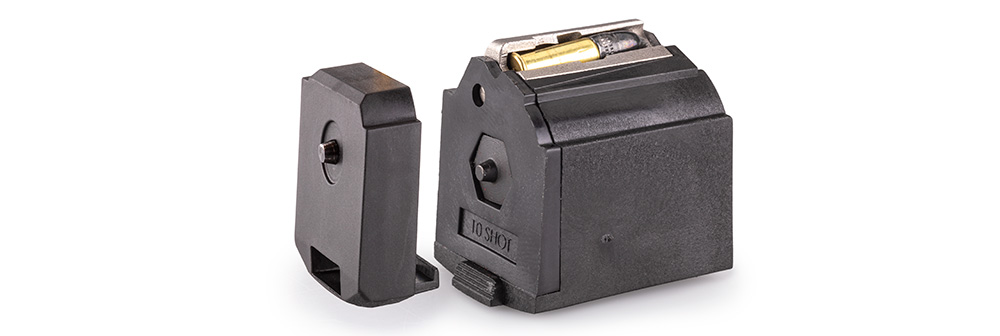
At the heart of the Force B1, though, is the textured collar at the front of the receiver that enables fast, easy barrel swaps, making the rifle one of the most versatile small-caliber arms seen on the market in recent memory. Each Force B1 barrel has an annular ring located just forward of the chamber. At the rear of the barrel is an extractor cut, as well as a U-shaped indexing point. With the bolt back, simply pull the collar, which releases the bearings locking the barrel into position, and pull the barrel straight out of the action.
Replacing it with another barrel is as simple as holding the collar back and inserting a new barrel with the U-shaped index point at the 12-o’clock position. Once the spring-loaded collar is allowed to move forward under spring pressure, it forces eight spherical bearings located on the inside of the receiver into place, locking the new barrel into position. Due to the tolerances required to make this an easy swap, this isn’t a true return-to-zero process, so expect some point-of-impact shift. At launch, the carbon-steel barrels are available in 16" lengths. It’s likely we’ll see more barrels and future cartridge conversions down the line. All barrels are threaded 1/2x28 TPI at the muzzle and come with knurled thread protectors.
On the inside of the receiver, there’s a square bolt that shares similarities with a Ruger 10/22 bolt. Unlike a 10/22, though, the Hammerli’s bolt is not blowback-operated. Instead, the Force B1 is a locked-breech, manually operated straight-pull rifle. The large bolt handle on the gun’s right side is connected to an articulating arm located on the top of the bolt body, and the two-piece arm hinges during travel, guided by a cam located at the middle of the arm that locks the system into place. Pushing the action into battery requires some additional effort, so a red dot is located on the top of the articulating arm to indicate whether or not the bolt is in its locked position; if the red dot is visible, then the bolt isn’t locked fully forward.

The Force B1 does not have an out-of-battery safety, so the gun will still fire, even if the bolt is not fully locked. If the bolt still requires some distance to travel, then releasing the energy stored in the striker spring will close the gap between the bolt face and the cartridge rim, likely resulting in a light strike. If the bolt face is pressed up firmly against the cartridge rim but is not locked into position, the gun will fire, the bolt will be blown back into its open position and accuracy will suffer, not to mention the potential safety considerations that go along with firing a rifle without a fully locked action.
At the top of the receiver is a length of Picatinny rail with 15 slots, providing plenty of space for mounting an optic. Open sights are not available on the gun. At the bottom end of the rifle, there’s an ambidextrous magazine-release latch with serrations, as well as a reversible push-button safety and a bladed trigger with a pull weight that measured 5 lbs., 5 ozs., on my test sample. Two action screws are located on the underside of the stock, too, with one to the rear of the trigger and the other just forward of the magazine well. Disassembly is by way of an included 4 mm Allen wrench. Once the screws are removed, simply lift the barreled action out of the stock. Immediately noticeable is the 10/22-compatible trigger pack, held in place by two cross pins. The same hex wrench used to loosen the action screws can be used to push the pins out of the receiver, freeing the trigger and exposing the underside of the bolt. Removing it only requires racking the bolt to the rear, turning the action over so the open bottom is facing downward, then pulling the bolt downward, front face first.
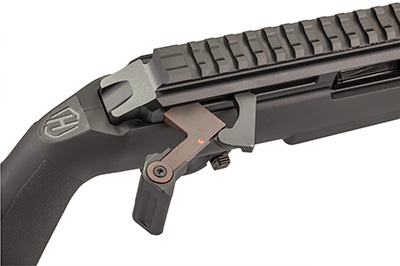
At first glance, the bolt is, for all intents and purposes, a 10/22 bolt, at least on its face and underside, which explains the Force B1’s 10/22 magazine compatibility. There’s a spring-loaded extractor at the 9-o’clock position, when viewed from the front, and a firing pin is located at 12 o’clock. At the top of the bolt is where the whole system works. A separate assembly is secured to the top portion of the bolt, sandwiching the firing pin and firing pin spring. Two turret-like protrusions project above the plane of the bolt, along with a third, offset stud located between the two.
Each of the two larger stems lock into a track located on the underside, top face of the receiver. Enlarged openings at the rear of the track enable the bolt to be removed for cleaning. The third nub is the connection point for the articulating bolt arm, the end of which has a round hole that slips over top of the nub when the bolt is installed. This is worth noting for reassembly reasons, as the end of the articulating lever that moves the bolt during operation swings freely after the bolt is removed. Therefore, some diligence on the part of the user is needed to locate the end of this arm and secure it atop the bolt in its proper place during re-assembly. Despite the manual’s instructions to the contrary, I found it easier to orient the receiver optic-rail-up during re-assembly and view the position of the handle arm and bolt nub through the slot in its right side in order to properly re-assemble the rifle.
A specially designed stock complements the Force B1 in its role as a highly versatile tool. The company’s basic model uses an injection-molded polymer design that incorporates a number of innovative features. At the fore-end, on its underside, are four M-Lok slots for adding a bipod, grip or other accessories. The manual makes it clear that this fore-end can also be swapped out for another handguard with more M-Lok attachment points on either side, though this additional accessory is not yet available. The grip is of a more vertical, target-style design, providing an easy grasping point that lends itself to a hold where the shooting-hand thumb rests on the gun’s offside position. A Hammerli “H” logo is molded centrally into the top center of the wrist, just below the tang. At the comb, a rubber insert provides a comfortable resting point for a shooter’s cheek, and the insert can be flipped, with the reverse side providing a higher point for use with a mounted optic. At the butt end of the rifle, there’s a comfortable rubber recoil pad and, at the top of the pad, there’s a spring-loaded button with a molded-in “H.” Pressing this button allows users to retract the butt to one of six positions to adjust length of pull.

The Venue
Nearly a year ago, I first became aware of Umarex’s plans to launch the Hammerli Force B1, and the company planned the launch in a big way. It’s fitting, because unlike previous Umarex product launches, this one is being released worldwide. Before, guns would be released selectively to the U.S., European or other markets. This time, every market where the Force B1 can be legally bought and sold is finding out about the gun at the same time. One of these markets is Australia, and that’s where we headed for our field test of the Force B1.
Australia is one of many nations whose lawful citizens have been neutered by gun-controlling politicians. In the mid-1990s, the Australian government opportunistically took advantage of tragedy to rob human beings of their natural rights to keep and bear arms, leading to the destruction of tens of thousands of semi-automatic arms. Today, gun ownership in Australia is treated as a privilege and is restricted only to hunting and sport shooting. For those uses, the Force B1 proved itself to be an able and agile platform, particularly considering the limiting factors involved in producing a gun for use by Australian civilians.
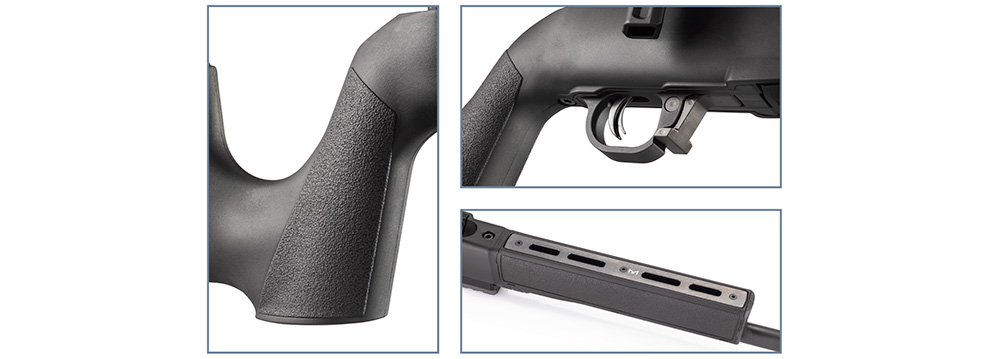
Within the realm of sport shooting, Australia has a lot to offer. But one animal exists in numbers far beyond any others on the southern continent, and their unchecked carnage has caused untold damage to the Australian landscape and cost farmers and ranchers there untold millions in lost crops and injured cattle. Bunnies. Sure, it sounds ridiculous at first, but rabbits are not indigenous to Australia. The cute critters were imported by the British in the late 1850s, notably by Alexander Buchanan, an overseer at a country estate in South Australia. Ironically, the sole reason for having them brought to Australia was for hunting. With few natural predators in sufficient numbers to keep the rabbit population in check, the immigrant rabbits bred like … well, you know. Before long, millions of them overran the continent. Australia’s sandy soil, held together by native grasses, eroded away when the grasses themselves were eaten by hordes of hungry rabbits. Too, deep, cavernous warrens dug by the creatures created huge holes capable of tripping up cattle, leading to injury and lost stock. Yet another unfortunate casualty are Australia’s native animals, many of whom eat the same grasses devoured by the newcomers. To keep the population in check, the Australian government, from time to time, introduces viruses into the native population, causing massive die-offs, sometimes of upwards of 90 percent of the continental population. The problem is that the remaining 10 percent, immune to the virus, stick around and breed like … yeah, that again. So, what’s to be done?
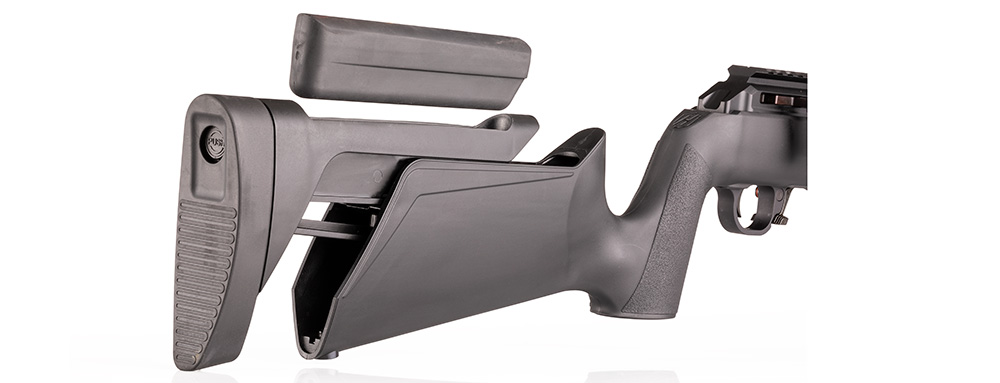
The Mission
In the vacillating temperatures of an Australian spring, we rolled down the blacktop from Adelaide, heading to the wild areas of South Australia where sheep graze, kangaroos hop, deer frolic and bunnies burrow. Just off the sandy coast of the Great Australian Bight, the landscape turns into rolling hills pockmarked by small groves of gum trees, tussock grass and flowering yucca, separated by rolling meadows of grassy plain. The spring landscape’s green recedes as the winter waters dissipate under the rising heat of the summer sun. The hard, barren soil of South Australia provides an ideal home for the cottontail rabbit, which digs deep into the ground under groves of trees and shrubs. The trees don’t mind it so much, from the looks of things, but the warrens wind their way across the landscape, growing and spreading to accommodate an ever-increasing number of the prodigious little breeders. Ravines and desolate, moonlike landscapes attest to their destructive powers.
We arrived at the Caora Homestead, an outpost of Happy Hunting Adventures, a crew of nine shooters ready to make a dent in the rabbit population. The guns had only arrived the day before, thanks to the intrepid efforts of Walther’s local Aussies, Harry and Pat. None had optics, and all had fresh barrels from Hammerli’s initial production run. After more than 30 hours of travel, we unloaded our gear and set about zeroing the fresh rifles. Topped by Vortex glass and outfitted with Magpul bipods, the array of Force B1 rifles illustrated the versatility of the new line. Guns were outfitted with short barrels, long barrels, laminate stocks, polymer stocks, .22 LR barrels, .22 WMR barrels, red-dots and magnified optics. A zeroing session got all the guns hitting where they needed to be, and we headed out the next morning.
Across three and a half days of hunting, thousands of rabbits were dispatched. During my first day of shooting, I used a .22 Long Rifle-chambered version with a laminate stock and magnified optic. Shot distances ranged from only a few yards out to just over 100 yards. The following day, we swapped out the .22 LR barrel for a .22 WMR barrel, which took only a few seconds. Re-zeroing the rifle was necessary, and after that, we enjoyed the much more substantial capability of the magnum-chambered rifle. After the swap, there was a noticeable increase in the amount of effort required to push the bolt fully into battery. A subsequent discussion with Matthias Strack, CEO managing director of Umarex, highlighted the reason why. A .22 Long Rifle case and a .22 WMR case have very slightly different rim thicknesses, with the WMR being 0.007" thicker than the .22 LR’s 0.043" thick rim. When the rifles are headspaced, the positioning of the barrel has to accommodate both cartridges, so ensuring proper headspace for the .22 Long Rifle means there’s just a bit more oomph needed to lock the bolt into battery for the .22 WMR. It’s by no means difficult, but it is noticeable. Those moving to the more powerful chambering will need to be mindful of this difference and be sure that the bolt is fully in battery.
For both chamberings, there’s a noticeable click when the bolt finally locks, and that’s the tactile and audible cue that the gun’s ready to fire. For day three, I moved back to the .22 Long Rifle, but this time, I spent the day with the lighter, handier polymer-stock variant with a short barrel and a mounted red-dot optic. With this rifle, shots were taken off-hand and on running rabbits, with great effect. No doubt, it’s a handy rifle that leads well and comes up to the shoulder easily, making for almost effortless shots on game. Working the bolt took some getting used to. Unlike other straight-pull rimfires, notably the Browning T-Bolt, the bolt on the Force B1 uses a biathlon-style handle that’s meant to be grabbed with several fingers of the shooting hand, pulled to the rear, then pushed forward into battery, with an extra short push at the end to snap the bolt into battery. After a few magazines, operating the action became second nature. During the hunt, after firing several hundred rounds, we noticed several sharp edges where the molded polymer section of the bolt handle met the metal articulating arm actuating the bolt. Hammerli’s representatives took note of these issues and have indicated that work will be done on future production samples to dehorn these edges. Ultimately, the Hammerli Force B1 accounted for more than a thousand rabbits across three days of hunting in the Australian wilds. Along the way, nearly all the guns ran without a hitch, though there were a few stoppages that were quickly cleared by dropping the magazine and running the bolt. One test rifle, exposed to the fine, sandy grit of an Australian dune, became quite difficult to operate, but a cleaning of the rifle returned it to normal function.
The Results
After returning from Australia, I received a bona-fide production rifle from Hammerli to put through our testing protocols. In the sterile confines of the NRA Publications test range, the Force B1 provided several stellar groups, particularly with Eley’s subsonic match rounds, as seen in the nearby results table. One overarching observation on ammunition selection is that the Force B1 seemed to greatly prefer subsonic ammunition. The higher the velocity, the less stellar the groups seen downrange. Certainly, given the gun’s propensity for slower loads, its locked-breech, manually operated action and its threaded barrels, it seems eminently suited for suppressor use.
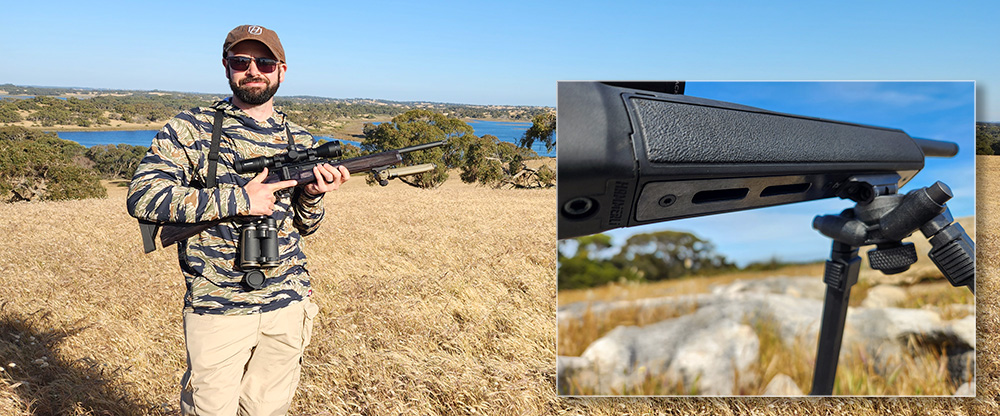
As far as field use goes, sure, it’s great as an Australian rabbit rifle, but what does that matter for the American market? It’s true that the United States is overrun with rimfire rifles of every description, but a vanishingly small number of them can swap out cartridges at all, let alone with the ease possible in the Hammerli system. The strength of the locking collar is such that it wouldn’t be surprising to see other calibers down the road, enabling the action to expand beyond rimfire offerings. The speed of the straight-pull action advances the Force B1 above other manually operated rimfires, and while it doesn’t equal the speed of a semi-automatic, you’ll avoid the noisy clanking of a big semi-auto bolt ruining your silenced shooting experience. Price? The rifle itself retails for $649, and spare barrels, I’m told, will be available for around $200. Effectively, you can have two rifles in one for less than $850, saving you money and space.
In the end, the Hammerli Force B1 is affordable, accurate, versatile, easy to use, quiet and is compatible with 10/22 magazines. What more could you want?





































